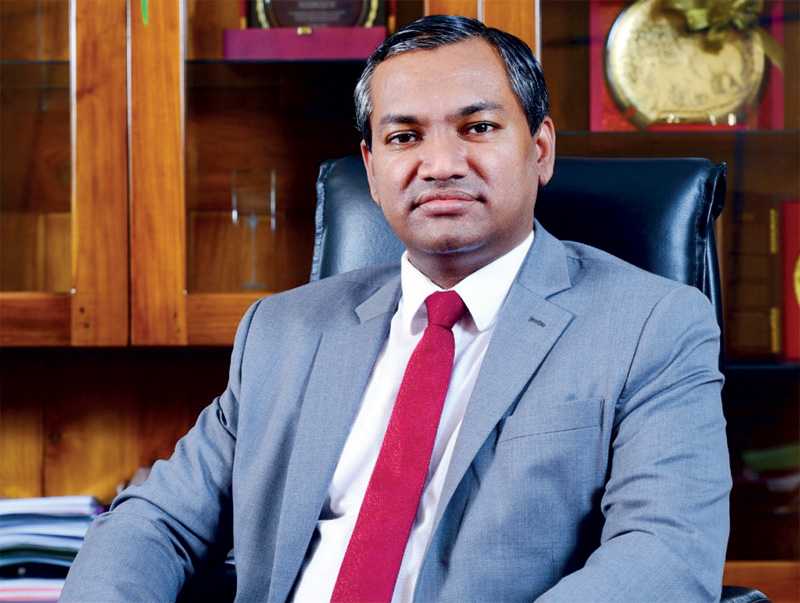Tuesday Nov 25, 2025
Tuesday Nov 25, 2025
Thursday, 5 November 2020 01:18 - - {{hitsCtrl.values.hits}}

TRCSL Director General Oshala Senanayake
TRCSL Director General Oshala Senanayake says the fintech services are certainly set to move beyond just cash transactions and would evolve into a broader service that includes concepts such as Mobile Connect that could facilitate KYC checks and unify further services across diverse cross operator networks. Following are excerpts of the interview:
By Cathrine Weerakkody 
Q: Sri Lanka’s telecommunications sector, which has made considerable progress in recent years has slowed down due to the high cost of investment, etc. How do you see this industry doing in the new economy?
The telecommunications industry is by nature, a high capex intensive sector, and there is a multitude of factors that contribute to slow progress. Some factors could be attributed to internal organisational dynamics as well as external macro-environmental issues. Examples of external factors could include government policies, tax regimes, as well as a weak regulatory framework. Economic factors include demographics such as income and spending power of the target audience.
From a local perspective, further internal dynamics of which legal litigation amongst the industry has further contributed to an impasse within service providers which has been resolved now by the regulator which has now paved the way for growth. In the pandemic digitalisation has been embraced as the new norm, the telecommunications sector has a golden opportunity as well as an obligation in providing the critical infrastructure required for digitalisation which is universal connectivity.
With the lives of citizens centred on a digitalised environment, a paradigm shift is to be seen on the consumption of services for all facets of life that include work, education as well as leisure. These phenomena translate to more and more consumption of data as well as the need for emerging services such as online entertainment, Home and Industrial Automation based on IOT technology and cloud services for the corporate sectors, etc. which defines a clear convergence of most services around the telecommunication sector.
Q: What is the role of the regulator?
The regulator has a key role to play in terms of enabling and empowering the telecom industry, by ensuring timely regulatory and policy decision making, sector expansion, effective spectrum management, proactive spectrum planning for future technologies such as 5G as well as streamlined approval mechanisms.
Q: The telecommunications industry of Sri Lanka is dominated by Mobile and Fixed Industry segments comprised of four Mobile Operators and three Fixed Access Operators which collectively contribute to the total industry revenue by 96%. There are 25 other system licensees who contribute to the remaining 4% of industry revenue. Will there be a consolidation in the industry given the high cost of infrastructure and talent?
While the cost of infrastructure is a common trait for the telecommunication sector, the post-COVID era opportunities are set to provide an equaliser in terms of a broader opportunity of creating new revenue for the sector. In this sense focusing on the four mobile operators within the sector, it could be segmented to a model of two main operators and the other two being smaller operators with a niche target segment that is focused by respective operators.
From a regulator perspective, the current structure provides a healthy environment where it’s important that a telecommunications industry is not pushed towards a monopolistic environment. The current composition of operators is expected to provide a healthy competitive environment providing the best possible market forces that would in turn provide the optimum value propositions for consumers from an industry perspective.
Q: Is there a possibility of this composition changing over time?
A change in the composition is quite possible in the future with potential mergers and acquisitions where the regulator should ensure that it does not disrupt the industry equilibrium. In terms of other system licensee holders or service providers such as Direct to Home Satellite services and Cable TV services, it is expected such services would possibly be a converged service which would be dominated by the incumbent telecommunications service providers which provide them with the opportunity of providing a compelling value proposition of providing such services as a bundled service in addition to the core services such as mobile and broadband offerings.
With the need to progress towards 5G technology, it is pertinent to note that the current analogue terrestrial TV broadcasting methodology is shifted to digital broadcasting enabling the clearing of prime spectrum bands for 5G which is now utilised for analogue TV broadcasting.
Q: TRCSL is expected to take necessary steps in keeping with the Government’s policy for the development of the telecom sector, especially in expanding connectivity in the country. What are some of these plans?
In terms of the Government’s vision of a Smart Sri Lanka driven by a digital economy in the future, the key imperatives for the TRCSL being the regulator of telecommunications are multi-fold out of which the key priority is to ensure island wide broadband connectivity that would be the underlying foundation for a future digitally driven society. Focusing on the above TRCSL has a well-articulated five-year plan that further synchronised with the International Telecommunication Union ‘Connect 2030’ global agenda which is in fact driven by an overall vision of ‘Connecting All to a Better World’ with five tenets being focused on Growth, Inclusiveness, Sustainability, Innovation and Partnerships.
Focusing on the Growth TRCSL has launched an ambitious project called ‘Gamata Sannivedanaya’ which translates to ‘Connect Sri Lanka’ where the primary objective is to drive 100% 4G/Fiber broadband connectivity across all areas of Sri Lanka without any exception. TRCSL has further set in motion next steps in 5G technology rollout which is critical for enabling key elements of the government’s vision of digitalisation which include the creation of a knowledge-based economy through a Smart Sri Lanka enabled with technology. 5G technology would be key in the utilisation of IOT technology for industrial automation, Smart city enablement and the adoption of e-healthcare and agritech in future.
Q: Have you already started commercial 5G trials?
TRCSL has commenced initial 5G trials through all mobile operators in February 2020 and is currently in the process of finalising a national 5G spectrum policy and strategy in moving towards implementation of commercial 5G services in Sri Lanka.
Q: What about Number Portability and other initiatives?
The initiation of Mobile and Fixed Number Portability service which would provide the required mobility for the consumer to switch service providers by retaining the mobile number in use has been agreed with all operators. The technical deliberations are in progress. EMEI number management project is yet another critical project launched in October 2020 and would ensure that the country does not become a dumping ground for fake and smuggled mobile equipment.
TRCSL also has factored in special projects in reducing the digital divide in its long-term plans and have initiated the first ever complete free access to online e-learning platforms for all government schools and universities namely e-Thaksalawa and LEARN university LMS with the support of the telecommunication industry which should be commended for enabling such a program in driving education especially during the COVID crisis and beyond.
The Lotus Tower would also be a pivotal element in the TRCSL’s long terms plans where currently commercial operations are expected to commence in early 2021 with the tower being positioned as an ‘Epicenter of Technology’ with a state-of-the-art innovation centre as well as other attractions.
Q: The Government seems fully focused on developing the digital infrastructure to have high- speed broadband Internet access reaching all sections of society. How is this progressing?
The Gamata Sannivedaya program launched in December 2019 is now in progress to address the lack of broadband connectivity, and preliminary work included an almost yearlong exercise of a survey across all 25 districts and 14,000 plus Grama Seva administrative areas in understanding the ground realities of actual coverage issues. The key element in this exercise is that the TRCSL would be financially investing into the expansion through its Telecom Development Fund providing an incentive for operators to provide coverage to rural areas that may not make financial sense from a company perspective but makes absolute economic sense from a government perspective.
TRCSL has already commenced the first project in the Ratnapura district with telco operators. It is expected that by April 2021 the Ratnapura district will be covered with broadband connectivity covering 6,002 National and Provincial schools, 23 Police Stations, 38 Hospitals and 1,400+ other government agencies.
Q: The spread of ICT, both in the urban and rural sectors, will enable ready access to important aspects of digital connectivity such as telemedicine, e-governance, e-commerce, distance learning and good entertainment. Is the country moving with a clear direction towards the establishment of the digital society in Sri Lanka?
The country is certainly moving in a well-articulated strategy in terms of digitalisation with required institutional frameworks set in place as national priorities for key digital stakeholder entities such as the TRCSL, ICTA and CERT. The key thrust areas of connectivity, digital transformation and cybersecurity initiatives are clear mandates amongst the above entities aligned to a common goal of a Digitally driven Smart Sri Lanka. The digitalisation of key government services as well as the adoption of cutting-edge technology through the private sector would pave the way for a truly digital society empowered with e-governance, e-commerce, e-health and agritech.
Q: Is there a clear line now between ‘banking’ and ‘mobile money’, and at what point does that line become blurred, as Telecom companies expand their services to include more than just sending cash?
Fintech services continue to disrupt traditional banking services, and convergence is here to stay with mobile operators providing such fintech platforms or partnering with fintech companies offering consumer agility of digital financial services leveraging on powerful marketing and distribution channels. The concept of carrier billing enabling consumers to aggregate payments through mobile operators for other services is yet another paradigm shift.
While mobile money platforms are here to stay, as any other technology, there are pros and cons of emerging technology where required regulatory measures should be introduced to ensure governance of such platforms. Such fintech services are certainly set to move beyond just cash transactions and would evolve into a broader service that includes concepts such as Mobile Connect that could facilitate KYC checks and unify further services across diverse cross operator networks in the future.
(The writer is a graduate in financial analysis, an Associate of CIMA, has a Master’s Degree in Financial Management and is currently reading for a PhD in England and lectures at the University of Buckingham.)